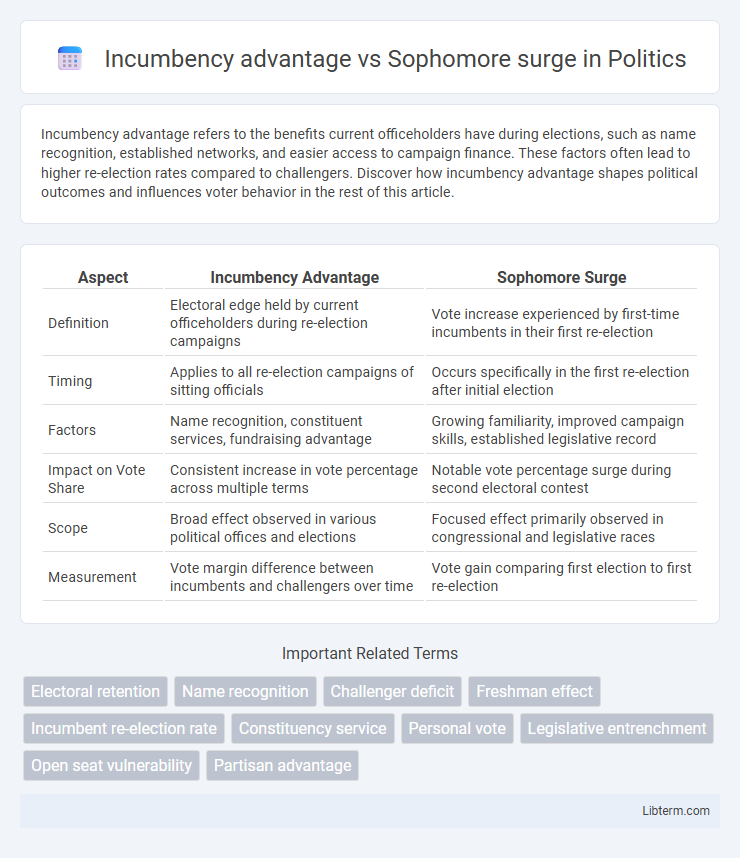Incumbency advantage refers to the benefits current officeholders have during elections, such as name recognition, established networks, and easier access to campaign finance. These factors often lead to higher re-election rates compared to challengers. Discover how incumbency advantage shapes political outcomes and influences voter behavior in the rest of this article.
Table of Comparison
| Aspect | Incumbency Advantage | Sophomore Surge |
|---|---|---|
| Definition | Electoral edge held by current officeholders during re-election campaigns | Vote increase experienced by first-time incumbents in their first re-election |
| Timing | Applies to all re-election campaigns of sitting officials | Occurs specifically in the first re-election after initial election |
| Factors | Name recognition, constituent services, fundraising advantage | Growing familiarity, improved campaign skills, established legislative record |
| Impact on Vote Share | Consistent increase in vote percentage across multiple terms | Notable vote percentage surge during second electoral contest |
| Scope | Broad effect observed in various political offices and elections | Focused effect primarily observed in congressional and legislative races |
| Measurement | Vote margin difference between incumbents and challengers over time | Vote gain comparing first election to first re-election |
Understanding Incumbency Advantage
Incumbency advantage refers to the electoral edge that sitting officeholders possess due to name recognition, established campaign infrastructure, and greater access to resources compared to challengers. This advantage often leads to higher reelection rates and increased voter trust, stemming from the officeholder's ability to showcase past accomplishments and constituent services. Understanding incumbency advantage helps explain electoral stability and the difficulty challengers face in unseating well-known politicians.
Defining the Sophomore Surge
The Sophomore surge refers to the significant increase in vote share that first-term incumbents often experience during their reelection campaigns. This phenomenon reflects growing name recognition, enhanced constituent services, and improved campaign organization compared to their initial election. Unlike the broader incumbency advantage, the Sophomore surge specifically highlights the boost gained between a candidate's first and second election cycles.
Historical Trends in Incumbency Advantage
Historical trends in incumbency advantage reveal that sitting legislators typically enjoy a significant boost in vote share during re-election campaigns due to established name recognition, access to campaign finance, and constituent services. The sophomore surge refers to the common phenomenon where newly elected politicians experience a pronounced increase in vote share during their first re-election bid, reflecting growing voter familiarity and campaign infrastructure. Over time, incumbency advantage has remained a consistent factor in electoral success, with the sophomore surge serving as an early indicator of entrenched electoral strength.
Measuring the Sophomore Surge Effect
Measuring the Sophomore Surge Effect involves quantifying the increase in vote share that first-term candidates typically experience when running for re-election, reflecting voters' growing familiarity and approval. This effect is distinguished from the incumbency advantage by isolating the specific boost observed after the initial election cycle, often calculated by comparing vote percentages between a candidate's first and second campaigns. Analytical methods utilize election data over multiple cycles to assess the magnitude and consistency of the sophomore surge across different districts and political environments.
Key Differences Between Incumbency and Sophomore Surge
Incumbency advantage refers to the electoral edge experienced by sitting officeholders due to greater name recognition, access to campaign finance, and constituent services, while sophomore surge describes the significant increase in vote share that first-term incumbents typically gain during their first re-election campaign. The key difference lies in scope: incumbency advantage applies broadly to all reelection campaigns by sitting officials, whereas sophomore surge specifically measures the jump in voter support from an initial election to the first re-election. Understanding these distinctions is crucial for analyzing electoral dynamics and the durability of political careers.
Factors Influencing Incumbency Success
Incumbency advantage is driven by factors such as name recognition, access to campaign finance, and constituent services that boost voter loyalty. Sophomore surge reflects the increased vote share that first-term incumbents often experience due to greater visibility and established networks. Both phenomena underscore the importance of incumbency in electoral success through accumulated resources and enhanced voter contact.
Case Studies: Notable Sophomore Surges
Notable sophomore surges illustrate significant vote share increases for first-term incumbents, such as Bill Clinton's 1986 Arkansas gubernatorial campaign, where his margin expanded substantially from his initial election. In congressional races, examples like Barack Obama's 2006 re-election to the Illinois State Senate demonstrate how sophomore surges can solidify political standing and boost fundraising capabilities. These case studies highlight the phenomenon of incumbency advantage manifesting early in political careers, challenging the conventional expectation of gradual incumbency benefits over multiple terms.
Impact on Election Outcomes
Incumbency advantage significantly boosts election outcomes by providing sitting candidates increased name recognition, established donor networks, and constituent service records, often leading to higher re-election rates. Sophomore surge refers to the substantial vote increase newly elected representatives experience in their first re-election campaign, typically ranging from 5% to 10%, which helps solidify their electoral footing. Both phenomena contribute to electoral stability by reinforcing the position of incumbents and enhancing their chances of securing continued tenure in legislative bodies.
Challenges to the Incumbency Advantage
Challenges to the incumbency advantage arise from factors such as increasing voter volatility, redistricting, and higher campaign financing costs that level the playing field for challengers. Sophomore surge, characterized by a significant vote increase experienced by first-term incumbents, may diminish as electoral competitiveness intensifies and party identification weakens. Changes in media environment and voter mobilization efforts also erode traditional advantages held by incumbents in congressional elections.
The Future of Incumbency and Sophomore Surge
The future of incumbency advantage and sophomore surge in electoral politics will increasingly depend on factors such as media influence, changing voter behavior, and campaign technology innovations. Incumbents are likely to maintain an edge due to established name recognition and constituent services, but sophomore candidates may narrow the gap by leveraging social media and data-driven outreach. Emerging trends suggest a dynamic interplay where digital engagement reshapes traditional advantages in elections.
Incumbency advantage Infographic

 libterm.com
libterm.com